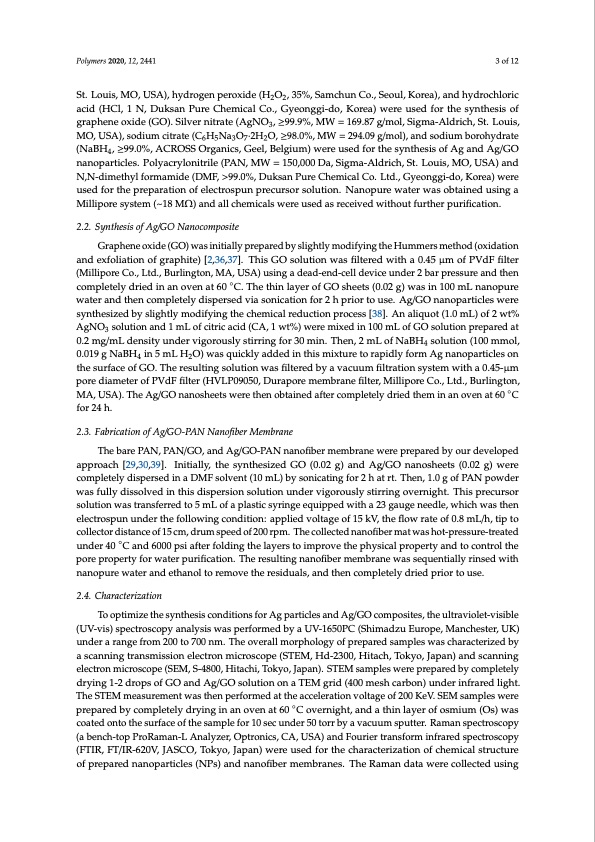
PDF Publication Title:
Text from PDF Page: 003
Polymers 2020, 12, 2441 3 of 12 St. Louis, MO, USA), hydrogen peroxide (H2O2, 35%, Samchun Co., Seoul, Korea), and hydrochloric acid (HCl, 1 N, Duksan Pure Chemical Co., Gyeonggi-do, Korea) were used for the synthesis of graphene oxide (GO). Silver nitrate (AgNO3, ≥99.9%, MW = 169.87 g/mol, Sigma-Aldrich, St. Louis, MO, USA), sodium citrate (C6H5Na3O7·2H2O, ≥98.0%, MW = 294.09 g/mol), and sodium borohydrate (NaBH4, ≥99.0%, ACROSS Organics, Geel, Belgium) were used for the synthesis of Ag and Ag/GO nanoparticles. Polyacrylonitrile (PAN, MW = 150,000 Da, Sigma-Aldrich, St. Louis, MO, USA) and N,N-dimethyl formamide (DMF, >99.0%, Duksan Pure Chemical Co. Ltd., Gyeonggi-do, Korea) were used for the preparation of electrospun precursor solution. Nanopure water was obtained using a Millipore system (~18 MΩ) and all chemicals were used as received without further purification. 2.2. Synthesis of Ag/GO Nanocomposite Graphene oxide (GO) was initially prepared by slightly modifying the Hummers method (oxidation and exfoliation of graphite) [2,36,37]. This GO solution was filtered with a 0.45 μm of PVdF filter (Millipore Co., Ltd., Burlington, MA, USA) using a dead-end-cell device under 2 bar pressure and then completely dried in an oven at 60 ◦C. The thin layer of GO sheets (0.02 g) was in 100 mL nanopure water and then completely dispersed via sonication for 2 h prior to use. Ag/GO nanoparticles were synthesized by slightly modifying the chemical reduction process [38]. An aliquot (1.0 mL) of 2 wt% AgNO3 solution and 1 mL of citric acid (CA, 1 wt%) were mixed in 100 mL of GO solution prepared at 0.2 mg/mL density under vigorously stirring for 30 min. Then, 2 mL of NaBH4 solution (100 mmol, 0.019 g NaBH4 in 5 mL H2O) was quickly added in this mixture to rapidly form Ag nanoparticles on the surface of GO. The resulting solution was filtered by a vacuum filtration system with a 0.45-μm pore diameter of PVdF filter (HVLP09050, Durapore membrane filter, Millipore Co., Ltd., Burlington, MA, USA). The Ag/GO nanosheets were then obtained after completely dried them in an oven at 60 ◦C for 24 h. 2.3. Fabrication of Ag/GO-PAN Nanofiber Membrane The bare PAN, PAN/GO, and Ag/GO-PAN nanofiber membrane were prepared by our developed approach [29,30,39]. Initially, the synthesized GO (0.02 g) and Ag/GO nanosheets (0.02 g) were completely dispersed in a DMF solvent (10 mL) by sonicating for 2 h at rt. Then, 1.0 g of PAN powder was fully dissolved in this dispersion solution under vigorously stirring overnight. This precursor solution was transferred to 5 mL of a plastic syringe equipped with a 23 gauge needle, which was then electrospun under the following condition: applied voltage of 15 kV, the flow rate of 0.8 mL/h, tip to collector distance of 15 cm, drum speed of 200 rpm. The collected nanofiber mat was hot-pressure-treated under 40 ◦C and 6000 psi after folding the layers to improve the physical property and to control the pore property for water purification. The resulting nanofiber membrane was sequentially rinsed with nanopure water and ethanol to remove the residuals, and then completely dried prior to use. 2.4. Characterization To optimize the synthesis conditions for Ag particles and Ag/GO composites, the ultraviolet-visible (UV-vis) spectroscopy analysis was performed by a UV-1650PC (Shimadzu Europe, Manchester, UK) under a range from 200 to 700 nm. The overall morphology of prepared samples was characterized by a scanning transmission electron microscope (STEM, Hd-2300, Hitach, Tokyo, Japan) and scanning electron microscope (SEM, S-4800, Hitachi, Tokyo, Japan). STEM samples were prepared by completely drying 1-2 drops of GO and Ag/GO solution on a TEM grid (400 mesh carbon) under infrared light. The STEM measurement was then performed at the acceleration voltage of 200 KeV. SEM samples were prepared by completely drying in an oven at 60 ◦C overnight, and a thin layer of osmium (Os) was coated onto the surface of the sample for 10 sec under 50 torr by a vacuum sputter. Raman spectroscopy (a bench-top ProRaman-L Analyzer, Optronics, CA, USA) and Fourier transform infrared spectroscopy (FTIR, FT/IR-620V, JASCO, Tokyo, Japan) were used for the characterization of chemical structure of prepared nanoparticles (NPs) and nanofiber membranes. The Raman data were collected usingPDF Image | Polyacrylonitrile Nanofiber Membrane Water Purification

PDF Search Title:
Polyacrylonitrile Nanofiber Membrane Water PurificationOriginal File Name Searched:
polymers-12-02441.pdfDIY PDF Search: Google It | Yahoo | Bing
Turbine and System Plans CAD CAM: Special for this month, any plans are $10,000 for complete Cad/Cam blueprints. License is for one build. Try before you buy a production license. More Info
Waste Heat Power Technology: Organic Rankine Cycle uses waste heat to make electricity, shaft horsepower and cooling. More Info
All Turbine and System Products: Infinity Turbine ORD systems, turbine generator sets, build plans and more to use your waste heat from 30C to 100C. More Info
CO2 Phase Change Demonstrator: CO2 goes supercritical at 30 C. This is a experimental platform which you can use to demonstrate phase change with low heat. Includes integration area for small CO2 turbine, static generator, and more. This can also be used for a GTL Gas to Liquids experimental platform. More Info
Introducing the Infinity Turbine Products Infinity Turbine develops and builds systems for making power from waste heat. It also is working on innovative strategies for storing, making, and deploying energy. More Info
Need Strategy? Use our Consulting and analyst services Infinity Turbine LLC is pleased to announce its consulting and analyst services. We have worked in the renewable energy industry as a researcher, developing sales and markets, along with may inventions and innovations. More Info
Made in USA with Global Energy Millennial Web Engine These pages were made with the Global Energy Web PDF Engine using Filemaker (Claris) software.
Infinity Turbine Developing Spinning Disc Reactor SDR or Spinning Disc Reactors reduce processing time for liquid production of Silver Nanoparticles.
| CONTACT TEL: 608-238-6001 Email: greg@infinityturbine.com | RSS | AMP |